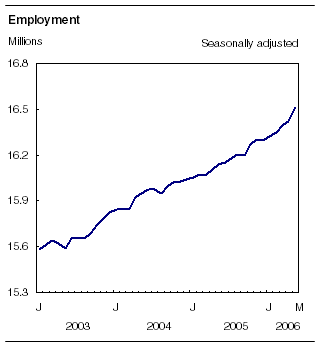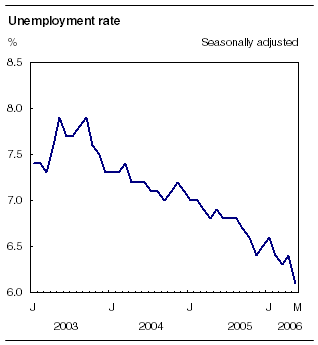
















 |
|
 |                |
Information identified as archived is provided for reference, research or recordkeeping purposes. It is not subject to the Government of Canada Web Standards and has not been altered or updated since it was archived. Please "contact us" to request a format other than those available.

|

Friday, June 9, 2006 Labour Force Survey
Employment increased by an estimated 97,000 in May, matching the high reached in January 2002. This increase drove the unemployment rate down 0.3 percentage points to 6.1%, the lowest since December 1974. 
The sizeable gain in employment pushed the employment rate to an all-time high of 63.2%. Over the first five months of the year, employment has increased by 1.4% (+220,000). All of May's employment increase was in full time, up 151,000, the largest increase on record. This jump was due to new entrants to the labour market obtaining full-time employment and coincides with fewer people working part time.
While employment growth continued to surge ahead in Alberta, there were also large increases in Ontario and Quebec in May. Strength in the service industries in Ontario and Quebec more than offset continued declines in manufacturing. At the national level, employment fell in manufacturing as well as in educational services. However, there were large increases in a number of industries. The largest gains in May came in finance, insurance, real estate and leasing; health care and social assistance; and public administration. Employment is up in almost every industry over the last 12 months. Men, women and youths shared in May's employment gains. The healthy showing from youths is a continuation of the strong trend that began in September 2005. With strength in full-time employment and a falling unemployment rate, wages continue to rise. The average hourly wage in May was up 3.8% from 12 months ago, compared to the most recent 2.4% increase in the Consumer Price Index. Average hourly wages jumped by 7.3% in Alberta's tight labour market. 
Widespread industry gainsEmployment increased sharply in finance, insurance, real estate and leasing in May, up 31,000, bringing gains since the start of the year to 55,000 (+5.5%). The increase this month was concentrated in Quebec. In May, 23,000 more people were working in health care and social assistance. Compared to 12 months ago, employment in the industry is up 3.4%, with the bulk of the increase in hospitals. Employment rose by an estimated 22,000 in public administration, all at the municipal and provincial levels. Despite the increase in May, there were declines earlier in the year, leaving employment in the industry little changed from 12 months ago. In May, there were also more workers in accommodation and food services (+17,000), the first increase so far this year. Most of the gain occurred in Alberta. There was a decline of 22,000 in manufacturing in May, with losses spread between Ontario and Quebec. Since the end of 2002 when the downward trend for the industry began, employment has fallen by 8.0% (-187,000). Alberta boom continuesIn Alberta, employment rose by 32,000 in May, pushing the employment rate to a record high of 71.4%. Gains were fuelled by an increase in the population as workers migrated to a province where labour demand is high. In May, the unemployment rate edged down 0.1 percentage points to 3.4%. Alberta's added employment was primarily in the service industries, particularly in health care and social assistance; finance, insurance, real estate and leasing and in accommodation and food services. Employment also increased in construction. Natural resources was little changed in May, but has jumped by 14.0% since last December. Employment in Alberta has grown by 4.2% so far this year — the fastest rate of growth of all the provinces. Following moderate growth in the first four months of the year, employment in Ontario increased by 34,000 in May, pushing the unemployment rate down 0.3 percentage points to 5.9%. The manufacturing sector in Ontario continued to shed employees, with a decline of 13,000 in May. Since the start of the year, employment in manufacturing in Ontario has declined by 2.8% (-30,000). Ontario, however, has been able to weather declines in manufacturing thanks to strength from the service sector. Employment in retail and wholesale trade continued its upward trend, increasing by 26,000 in May. Professional, scientific and technical services also contributed to May's employment increases with an additional 21,000 workers. In contrast, employment was down in educational services (-17,000), yet remains 3.4% above the level from 12 months ago. Employment increased by 31,000 in Quebec in May, pushing the unemployment rate down 0.4 percentage points to 7.9%, the second lowest rate in the last 30 years. As with Alberta and Ontario, the employment increase was spurred by strength in the service sector which more than offset a decline of 12,000 in manufacturing. The largest increases were found in finance, insurance, real estate and leasing, up 20,000 as well as information, culture and recreation (+16,000). In New Brunswick, the unemployment rate fell to 8.6% in May, a record low for the province. The 0.5 percentage point decline in the unemployment rate, however, was the result of adult women and men leaving the labour force rather than an increase in employment. Record full-time gains in MayFull-time employment jumped by 151,000 in May, well in excess of the previous record increase. These gains were widespread, but were most pronounced in Ontario where full-time work increased by 80,000. In both Alberta and Quebec, nearly all of the employment increase in May came from full time (+28,000 and +27,000, respectively). While full-time employment in Alberta has grown by 5.0% since the start of the year, in Quebec, full time remains largely unchanged. Nationally, full-time employment has grown by 3.1% from 12 months ago. At the same time, part-time employment declined by 1.2%. Overall, total employment has grown by 2.3% over the period, suggesting that many part-timers may have switched to full-time work and that new labour force entrants are finding full-time employment. Youths drive employment growth in OntarioIn May, employment among youths (aged 15 to 24) in Canada increased by 25,000 (+1.0%). The bulk of this increase for youths was in Ontario where they contributed the lion's share of the overall employment increase (+24,000). So far this year, employment growth among youths in Ontario has been strong, up 2.6%. The same is true for Alberta, where youth employment has jumped by 5.4% since the start of the year. Despite a decline in May for youths in British Columbia, youth employment has been on an upward trend for 22 months. Since August 2004, youth employment in British Columbia has grown by 16.3% (+49,000). At the same time, their participation rate increased by 5.4 percentage points to 66.4% in May. (Note: From May to August, the Labour Force Survey collects labour market information about people aged 15 to 24 years who were attending school full-time in March and intending to return to school in the fall. Survey results for May give an early indication of the summer job market for older students aged 20 to 24, however, many students aged 15 to 19 are not yet out of school for the summer. Survey results for June, July and August will provide further insight into the summer job market. The published estimates are not seasonally adjusted, therefore comparisons can only be made on a year-over-year basis.) Older students aged 20 to 24 encountered a similar summer job market this May compared to May 2005. The employment rate edged down slightly (-0.3 percentage points) to 61.9% from the 15-year high reached last May. Employment among adult women strengthensIn May, employment for adult women (aged 25 and over) increased by 32,000 with full-time gains more than offsetting declines in part time. So far this year, employment has grown at a faster pace for this group than for adult men. Overall, employment among adult women was up by 2.0% (+126,000), while for adult men, it increased by 0.7% (+52,000). Following a decline in the participation rate among adult women in 2005, participation has rebounded 0.5 percentage points since February 2006, hitting 61.3% in May. Available on CANSIM: tables 282-0001 to 282-0042, 282-0047 to 282-0064 and 282-0069 to 282-0099. Definitions, data sources and methods: survey number 3701. Available at 7:00 a.m. on Statistics Canada's website. From the home page, choose Today's news releases from The Daily, then Latest Labour Force Survey. A more detailed summary, Labour Force Information, is available today for the week ending May 20 (71-001-XIE, free) from the Our products and services page of our website. LAN and bulk prices are available on request. The 2005 Labour Force Historical Review on CD-ROM (71F0004XCB, $209) is now available. LAN and bulk prices are available on request. Data tables are also available in the Canadian Statistics module of our website. The next release of the Labour Force Survey will be on Friday, July 7. For general information or to order data, contact Client Services (1-866-873-8788; 613-951-4090; labour@statcan.gc.ca). To enquire about the concepts, methods or data quality of this release, contact Vincent Ferrao (613-951-4750) or Danielle Zietsma (613-951-4243), Labour Statistics Division.
| |||||||||||||||||||||||||||||||||||||||||||||||||||||||||||||||||||||||||||||||||||||||||||||||||||||||||||||||||||||||||||||||||||||||||||||||||||||||||||||||||||||||||||||||||||||||||||||||||||||||||||||||||||||||||||||||||||||||||||||||||||||||||||||||||||||||||||||||||||||||||||||||||||||||||||||||||||||||||||||||||||||||||||||||||||||||||||||||||||||||||||||||||||||||||||||||||||||||||||||||||||||||||||||||||||||||||||||||||||||||||||||||||||||||||||||||||||||||||||||||||||||||||||||||||||||||||||||||||||||||||||||||||||||||||||||||||||||||||||||||||||||||||||||||||||||||||||||||||||||||||||||||||||||||||||||||||||||||||||||||||||
|
|
|